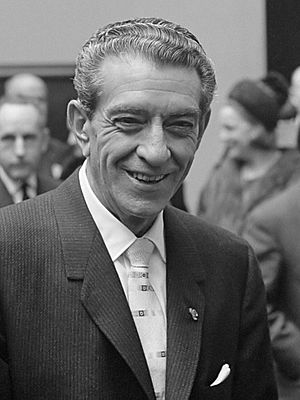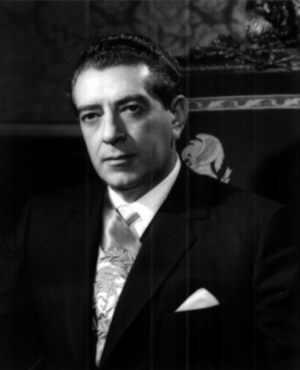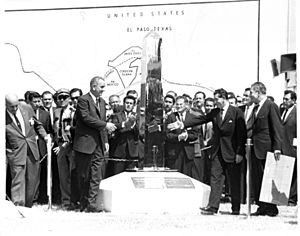Adolfo López Mateos facts for kids
Quick facts for kids
Adolfo López Mateos
|
|
|---|---|

Adolfo López Mateos in 1963
|
|
| 55th President of Mexico | |
| In office 1 December 1958 – 30 November 1964 |
|
| Preceded by | Adolfo Ruiz Cortines |
| Succeeded by | Gustavo Díaz Ordaz |
| Secretary of Labor and Social Welfare | |
| In office 1 December 1952 – 17 November 1957 |
|
| President | Adolfo Ruiz Cortines |
| Preceded by | Manuel Ramírez Vázquez |
| Succeeded by | Salomón González Blanco |
| Senator of Congress of the Union from the State of Mexico |
|
| In office 1 September 1946 – 31 August 1952 |
|
| Preceded by | Alfonso Flores |
| Succeeded by | Alfredo del Mazo Vélez |
| Personal details | |
| Born | 26 May 1909 Atizapán de Zaragoza, State of Mexico, Mexico |
| Died | 22 September 1969 (aged 60) Mexico City, Mexico |
| Political party | Institutional Revolutionary Party |
| Spouses |
Angelina Gutiérrez
(m. 1934; div. 1937)Eva Sámano
(m. 1937) |
| Relatives | Esperanza López Mateos (sister) |
| Alma mater | Scientific and Literary Institute of Toluca |
Adolfo López Mateos (born May 26, 1909 – died September 22, 1969) was a very important Mexican politician. He served as the President of Mexico from 1958 to 1964.
He started his political journey helping José Vasconcelos in his presidential campaign. Later, López Mateos became a professor. In 1941, he joined the Party of the Mexican Revolution. He was a senator for the State of Mexico from 1946 to 1952. Then, he became the Secretary of Labor under President Adolfo Ruiz Cortines from 1952 to 1957. He won the 1958 general election and became president.
López Mateos said his political ideas were "left within the Constitution." This meant he wanted to help ordinary people and make society fairer, while still following the country's laws. During his time as president, he created important institutions like the Institute for Social Security and Services for State Workers (ISSSTE). He also started the National Commission for Free Textbooks and the famous National Museum of Anthropology. He believed in not interfering in other countries' affairs. He also solved the Chamizal dispute with the United States. A big achievement was making Mexico's electricity industry owned by the government. This happened during a time of strong economic growth in Mexico.
Even with many good changes, there were also challenges. Some union leaders were arrested, and a peasant leader was sadly killed. However, many people still remember Adolfo López Mateos as one of Mexico's most popular presidents of the 20th century.
Contents
Early Life and Education
Adolfo López Mateos was officially born in Atizapán de Zaragoza, a small town in the State of Mexico. His father, Mariano Gerardo López y Sánchez Roman, was a dentist, and his mother, Elena Mateos y Vega, was a teacher. His family moved to Mexico City when he was young, after his father passed away. Some records suggest he might have been born in Guatemala, but the official records state Mexico.
In 1929, he finished his studies at the Scientific and Literary Institute of Toluca. There, he was a student leader who supported José Vasconcelos in his campaign against re-election. After Vasconcelos lost, López Mateos studied law at the National Autonomous University of Mexico. He then joined the National Revolutionary Party (PNR), which later became the Institutional Revolutionary Party (PRI).
Political Journey
Starting His Career
Early in his career, Adolfo López Mateos worked as a private secretary for the governor of the State of Mexico, Filiberto Gómez. In 1934, he became the private secretary for the president of the PNR, Carlos Riva Palacio.
He held several government jobs. In 1941, he met Isidro Fabela, who helped him become the director of the Literary Institute of Toluca. López Mateos became a senator for the State of Mexico in 1946. At the same time, he was the Secretary General of the PRI, his political party.
He played a key role in the presidential campaign of Adolfo Ruiz Cortines. After Ruiz Cortines won, López Mateos was appointed Secretary of Labor. He did such an excellent job that he was chosen to be the PRI's candidate for president. Since the PRI was the main party, López Mateos easily won the election. He served as president until 1964.
Presidency (1958–1964)
As president, Adolfo López Mateos continued the plans set by previous leaders like Miguel Alemán Valdés. These plans focused on making Mexico's industries stronger after World War II. In foreign policy, López Mateos wanted Mexico to be independent from the United States. However, they still worked together on some issues, even though Mexico disagreed with the U.S. approach to the 1959 Cuban Revolution.
Helping Workers
López Mateos wanted Mexico's industries to keep growing, a period often called the "Mexican Miracle." This growth needed workers to cooperate. However, many unions wanted better pay, working conditions, and more freedom from government control. López Mateos had been successful as Secretary of Labor, but as president, he faced big worker protests.
In 1958, railway workers, led by Demetrio Vallejo and Valentín Campa, started strikes for better wages. A major strike happened during Easter in 1959. The government arrested the union leaders, and some were sent to prison. The government also tried to reduce worker unrest by creating a system where companies shared 5% to 10% of their profits with organized labor. In 1960, the Constitution was changed to guarantee better salaries, paid holidays, and bonuses for government workers. The government also controlled prices and increased the minimum wage to help workers.
Working with Former Leaders
Lázaro Cárdenas, a former president, came out of retirement to encourage López Mateos to adopt more left-leaning policies. Cárdenas visited Cuba in 1959, which had just had its own revolution. He hoped to bring back the ideals of the Mexican Revolution, like land reform and better education and health services. He also asked López Mateos to free jailed union leaders.
López Mateos responded by taking actions similar to Cárdenas's policies. In 1960, he made the electric industry owned by the government. This was a big step for Mexico's economy. Other reforms, like land distribution, education changes, and social programs, also helped the poor. Eventually, Cárdenas supported López Mateos's choice for his successor, Gustavo Díaz Ordaz.
Helping the Country Grow
Land for Farmers
López Mateos carried out many social reforms. He strongly pushed for land reform, giving out 16 million hectares of land. This was the most land given out since Lázaro Cárdenas's presidency. The government also worked to improve the lives of ejidatarios, who are farmers who work on communal land.
Health and Social Programs
Public health campaigns were launched to fight diseases like polio, malaria, and tuberculosis. Diseases like typhus and smallpox were completely removed.
Helping people in poverty was a top goal. Spending on social welfare reached a high point of 19.2% of the total budget. New social programs were created, and existing ones were made better. Healthcare and pensions were improved, and new hospitals and clinics were built. The IMSS program, which provides social security, was expanded to rural areas. A new social security institute, ISSSTE, was created to offer childcare, medical services, and other help, especially for government employees. A food distribution system was set up to provide affordable basic foods for poor Mexicans. The government also started building a lot of low-cost housing. Between 1958 and 1964, over 50,000 low-income homes were built. One large housing project in Mexico City could house 100,000 people and included nurseries, clinics, and schools.
New Museums
López Mateos opened several major museums. The most famous is the National Museum of Anthropology in Chapultepec Park. The Museum of Modern Art was also opened in Chapultepec Park. His Minister of Education, Jaime Torres Bodet, helped a lot with these projects. Old colonial artworks were moved to the Museo del Virreinato. The Historical Museum of Mexico City was also established.
Better Education
To reduce illiteracy, adult education classes were brought back. A system of free and required school textbooks was also started. In 1959, the National Commission of Free Textbooks was created. This textbook program was debated because the government created the content, and using the books was mandatory. However, education became the largest part of the federal budget by 1963. There was a big focus on building new schools. Almost every village received help to build schools and get teachers and textbooks. Free breakfasts for primary school students were also brought back.
Student Involvement
Students became more interested in politics. The success of the Cuban Revolution in 1959 inspired many leftist students. However, the government's strong response to union and farmer protests soon extended to students. Students at the National Autonomous University of Mexico (UNAM) and the National Polytechnic Institute (IPN) became more involved in political demonstrations. These protests were sometimes met with government force. This tension grew larger later in the 1960s.
Fairer Elections
An effort was made to make elections more open. The constitution was changed to allow more opposition candidates to be represented in the Chamber of Deputies. This 1963 reform introduced "party deputies." Opposition parties could get five seats if they received at least 2.5% of the national vote, and more seats for additional votes. For example, in the 1964 elections, the Popular Socialist Party won 10 seats, and the National Action Party (PAN) won 20. This gave opposition parties a stronger voice in government, making Mexico appear more democratic.
The Army's Role
The army helped the government keep order and sometimes intervened in strikes. In 1961, López Mateos created more social security benefits for the military. The army had always been loyal to the government. During his presidency, a peasant leader named Rubén Jaramillo was killed along with his family in 1962. This event raised concerns among some intellectuals and showed a change in Mexico's political mood.
Foreign Relations

López Mateos had an important stance on the Cuban Revolution. As Cuba became more socialist, the U.S. pressured Latin American countries to isolate Cuba. However, Mexico believed in respecting Cuba's independence. Mexico followed the principle of "non-intervention in the internal affairs of countries" and "respect for the self-determination of nations."
During the Cuban Missile Crisis in October 1962, when the Soviet Union placed missiles in Cuba, Mexico voted for the removal of the weapons. But Mexico also called for a ban on invading Cuba. Mexico supported Cuba's right to govern itself.
López Mateos welcomed U.S. President John F. Kennedy to Mexico in July 1962 for a very successful visit. Mexico's firm stance on Cuba's independence, despite U.S. pressure, gave Mexico more influence with the U.S. because they shared a long border. During this time, the Chamizal dispute with the U.S. was finally solved. Most of the Chamizal area was given to Mexico, which was a big success for López Mateos's government.
Later Life
Adolfo López Mateos was the first chairman of the committee organizing the 1968 Summer Olympics in Mexico City. He also helped create the World Boxing Council.
He suffered from severe headaches, which were later diagnosed as several cerebral aneurysms. After being in a coma for several years, he passed away in Mexico City in 1969 due to an aneurysm. His wife, Eva Sámano, was buried next to him in the Panteón Jardín in Mexico City after her death in 1984.
In his last year as president, López Mateos looked tired and thin. He had seven aneurysms. After his presidency, he briefly led the Olympic Committee for the 1968 Games but had to resign due to his declining health. He gradually became unable to walk and lost his voice after a medical procedure.
Remembering Adolfo López Mateos
When Carlos Salinas de Gortari became president of Mexico (1988-1994), he had the remains of López Mateos and his wife moved to López Mateos's birthplace in the State of Mexico. A monument was built there to honor the late president. The town is now officially named Ciudad López Mateos.
See Also
 In Spanish: Adolfo López Mateos para niños
In Spanish: Adolfo López Mateos para niños





